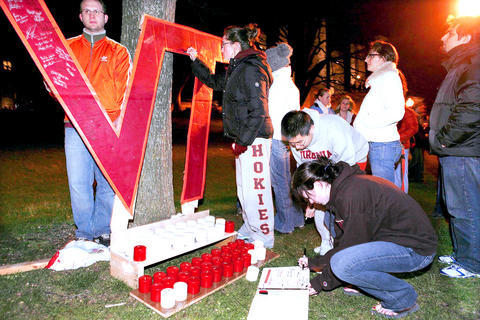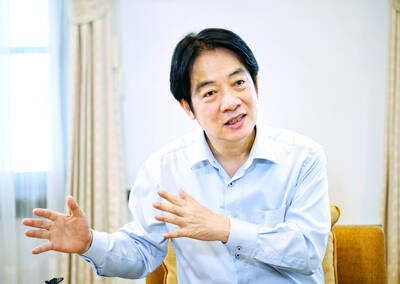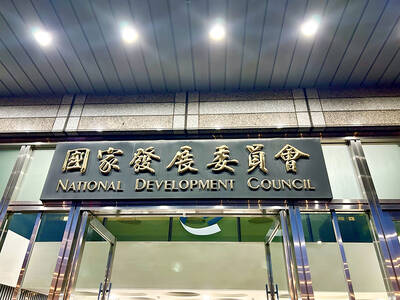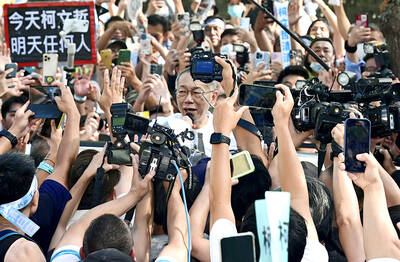The gunman in two campus attacks that claimed 33 lives, including his own, at Virginia Tech University was a South Korean citizen and a fourth-year student in the university's English department, school officials said at a press conference yesterday.
Virginia Tech police chief Wendell Flinchum identified the gunman as Cho Seung-hui, 23.
Flinchum also said the same gun was used at both shooting sites, but he would not rule out the existence of "accomplices."

PHOTO: EPA
However, there was no evidence presented that there was a second gunman involved.
"It's certainly reasonable to assume that Cho was the shooter in both cases,'' but authorities have not made the link for sure, said Colonel Steve Flaherty, superintendent of the Virginia State Police.
No motive for the shootings has been given.
Cho was a permanent resident of the US and his identity was confirmed with a positive fingerprint match on the guns used in the rampage and with US immigration materials, ABC News reported on its Web site, without identifying its sources.
He lived on the school campus.
The gunman struck down two people at a dormitory on Monday before killing 30 more people in four different classrooms and in a stairwell of a campus building and finally killing himself with a shot to his head in one of the classrooms.
University president Charles Steger said yesterday that classes had been canceled for the rest of the week. He also announced that the classroom building, Norris Hall, would be closed for the remainder of the semester.
Steger also defended the school's delay in warning students about what became the deadliest shooting rampage in US history.
Some students said their first warning came more than two hours after the first shooting, in an e-mail at 9:26am. By then the second shooting had begun.
"I think the university has blood on their hands because of their lack of action after the first incident," said Billy Bason, 18, who lives on the seventh floor of West Ambler Johnston, the high-rise coed dormitory where the shooting spree began.
Steger said the university was trying to notify students who were already on-campus, not those who were commuting in.
"We warned the students that we thought were immediately impacted," he told CNN. "We felt that confining them to the classroom was how to keep them safest."
He said investigators did not know there was a shooter loose on campus in the interval between the two shootings because the first could have been a murder-suicide.
Two students told NBC TV's Today show they were unaware of the dorm shooting when they reported to a German class where the gunman later opened fire.
Derek O'Dell, his arm in a cast after being shot, described a shooter who fired away in "eerily silence" with "no specific target -- just taking out anybody he could."
After the gunman left the room, students could hear him shooting other people down the hall. O'Dell said he and other students barricaded the door so the shooter couldn't get back in -- though he later tried.
"After he couldn't get the door open he tried shooting it open ... but the gunshots were blunted by the door," O'Dell said.
President George W. Bush and first lady Laura Bush were planning to attend a 2pm convocation yesterday, and people sought comfort on Monday night at a church service on the campus.
The shooting began about 7:15am on the dorm's fourth floor.
Police were still investigating around 9:15am, when a gunman wielding two handguns and carrying multiple clips of ammunition stormed Norris Hall, a classroom building 0.8km away on the 1,052 hectare campus.
At least 15 people were hurt in the second attack, some seriously. Many found themselves trapped after someone, apparently the shooter, chained and locked Norris Hall doors from the inside.
Students jumped from windows, and students and faculty carried away some of the wounded.
Police commandos swarmed over the campus. A student used his cell-phone camera to record the sound of bullets echoing through a stone building.
Inside Norris, the attack began with a thunderous sound from Room 206 -- "what sounded like an enormous hammer," said Alec Calhoun, a 20-year-old junior who was in a solid mechanics lecture in a classroom next door.
Screams followed an instant later, and the banging continued. When students realized the sounds were gunshots, Calhoun said, he started flipping over desks to make hiding places.
Others dashed to the windows of the second-floor classroom, kicking out the screens and jumping from the ledge of Room 204, he said.
"I must've been the eighth or ninth person who jumped, and I think I was the last," Calhoun said.
He landed in a bush and ran.
Calhoun said that the two students behind him were shot, but that he believed they survived. Just before he climbed out the window, Calhoun said, he turned to look at his professor, who had stayed behind, apparently to prevent the gunman from opening the door.
The instructor was killed, Calhoun said.
Erin Sheehan, who was in the German class next door to Calhoun's class, told the student newspaper, the Collegiate Times, that she was one of only four of about two dozen people in the class to walk out of the room. The rest were dead or wounded, she said.
She said the gunman "was just a normal-looking kid, Asian, but he had on a Boy Scout-type outfit. He wore a tan button-up vest, and this black vest, maybe it was for ammo or something."
The gunman first shot the professor in the head and then fired on the class, another student, Trey Perkins, told the Washington Post.
The gunman was about 19 years old and had a "very serious but very calm look on his face," he said.
"Everyone hit the floor at that moment," said Perkins, a second year student studying mechanical engineering. "And the shots seemed like it lasted forever."
At an evening news conference, Police Chief Wendell Flinchum refused to dismiss the possibility that a co-conspirator or second shooter was involved. He said police had interviewed a male who was a "person of interest" in the dorm shooting and who knew one of the victims, but he declined to give details.
Steger said authorities believed the shooting at the dorm was a domestic dispute and mistakenly thought the gunman had fled the campus.
"We had no reason to suspect any other incident was going to occur," he said.
Steger emphasized that the university closed off the dorm after the first attack and decided to rely on e-mail and other electronic means to spread the word, but said that with 11,000 people driving onto campus first thing in the morning, it was difficult to get the word out.
He said that before the e-mail was sent, the university began telephoning resident advisers in the dorms and sent people to knock on doors. Students were warned to stay inside and away from the windows.
"We can only make decisions based on the information you had at the time. You don't have hours to reflect on it," Steger said.
The 9:26 e-mail had few details:
"A shooting incident occurred at West Amber Johnston earlier this morning. Police are on the scene and are investigating." The message warned students to be cautious and contact police about anything suspicious.
Until Monday, the deadliest shooting in modern US history was in Killeen, Texas, in 1991, when George Hennard plowed his pickup truck into a Luby's Cafeteria and shot 23 people to death, then himself.

GLOBAL ISSUE: If China annexes Taiwan, ‘it will not stop its expansion there, as it only becomes stronger and has more force to expand further,’ the president said China’s military and diplomatic expansion is not a sole issue for Taiwan, but one that risks world peace, President William Lai (賴清德) said yesterday, adding that Taiwan would stand with the alliance of democratic countries to preserve peace through deterrence. Lai made the remark in an exclusive interview with the Chinese-language Liberty Times (sister paper of the Taipei Times). “China is strategically pushing forward to change the international order,” Lai said, adding that China established the Asia Infrastructure Investment Bank, launched the Belt and Road Initiative, and pushed for yuan internationalization, because it wants to replace the democratic rules-based international

ECONOMIC BOOST: Should the more than 23 million people eligible for the NT$10,000 handouts spend them the same way as in 2023, GDP could rise 0.5 percent, an official said Universal cash handouts of NT$10,000 (US$330) are to be disbursed late next month at the earliest — including to permanent residents and foreign residents married to Taiwanese — pending legislative approval, the Ministry of Finance said yesterday. The Executive Yuan yesterday approved the Special Act for Strengthening Economic, Social and National Security Resilience in Response to International Circumstances (因應國際情勢強化經濟社會及民生國安韌性特別條例). The NT$550 billion special budget includes NT$236 billion for the cash handouts, plus an additional NT$20 billion set aside as reserve funds, expected to be used to support industries. Handouts might begin one month after the bill is promulgated and would be completed within

The National Development Council (NDC) yesterday unveiled details of new regulations that ease restrictions on foreigners working or living in Taiwan, as part of a bid to attract skilled workers from abroad. The regulations, which could go into effect in the first quarter of next year, stem from amendments to the Act for the Recruitment and Employment of Foreign Professionals (外國專業人才延攬及僱用法) passed by lawmakers on Aug. 29. Students categorized as “overseas compatriots” would be allowed to stay and work in Taiwan in the two years after their graduation without obtaining additional permits, doing away with the evaluation process that is currently required,

RELEASED: Ko emerged from a courthouse before about 700 supporters, describing his year in custody as a period of ‘suffering’ and vowed to ‘not surrender’ Former Taiwan People’s Party (TPP) chairman Ko Wen-je (柯文哲) was released on NT$70 million (US$2.29 million) bail yesterday, bringing an end to his year-long incommunicado detention as he awaits trial on corruption charges. Under the conditions set by the Taipei District Court on Friday, Ko must remain at a registered address, wear a GPS-enabled ankle monitor and is prohibited from leaving the country. He is also barred from contacting codefendants or witnesses. After Ko’s wife, Peggy Chen (陳佩琪), posted bail, Ko was transported from the Taipei Detention Center to the Taipei District Court at 12:20pm, where he was fitted with the tracking